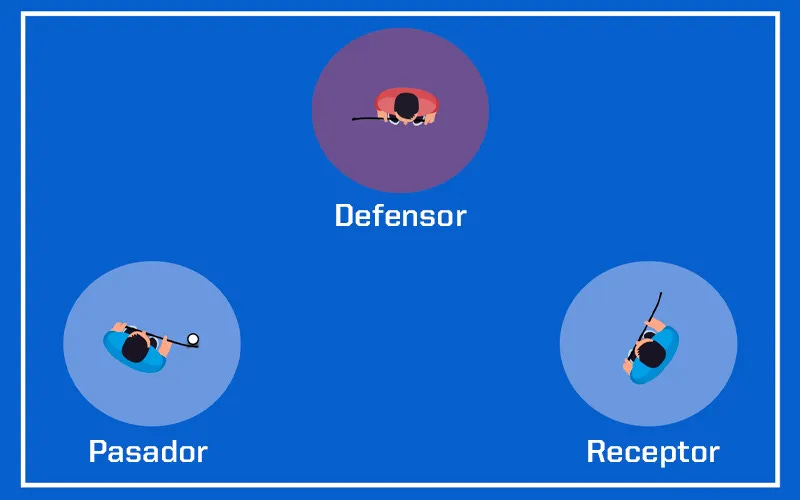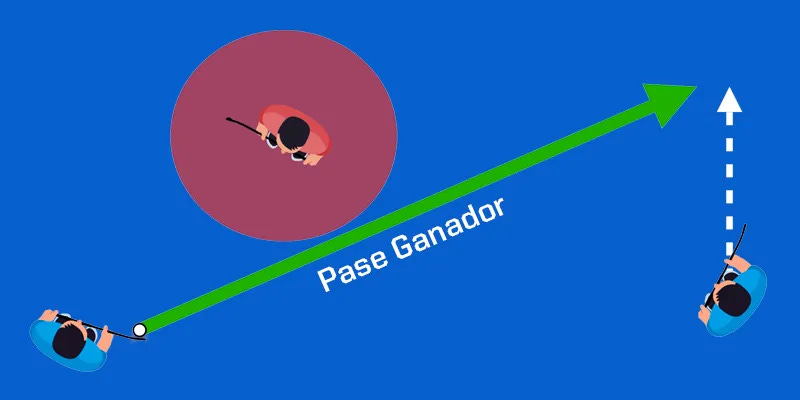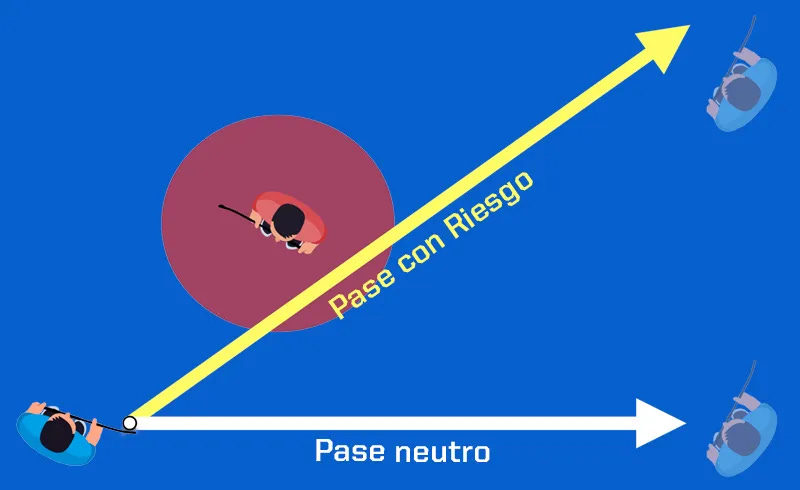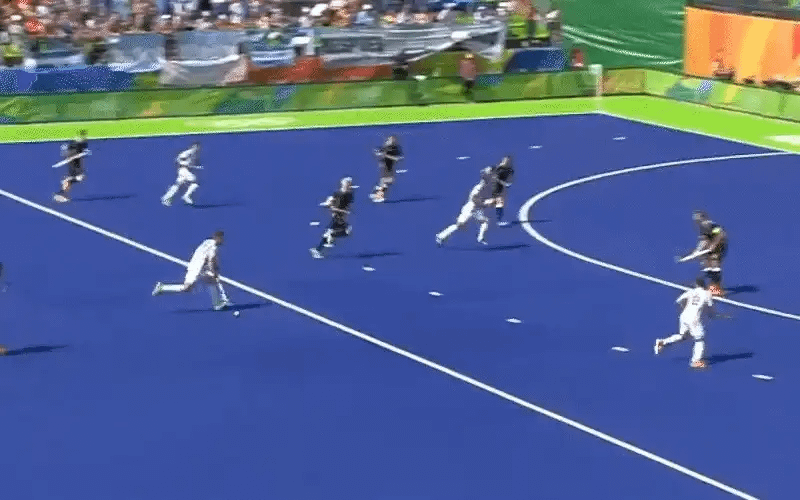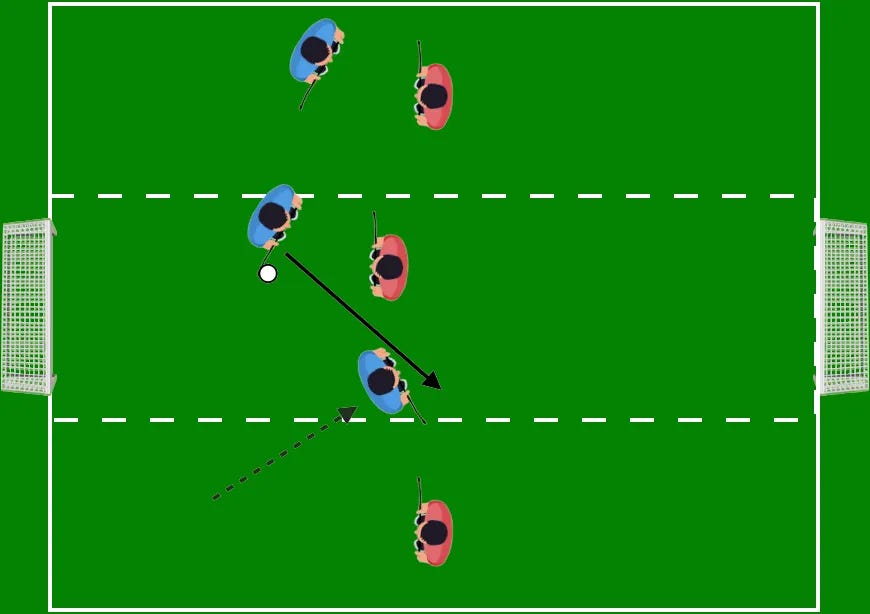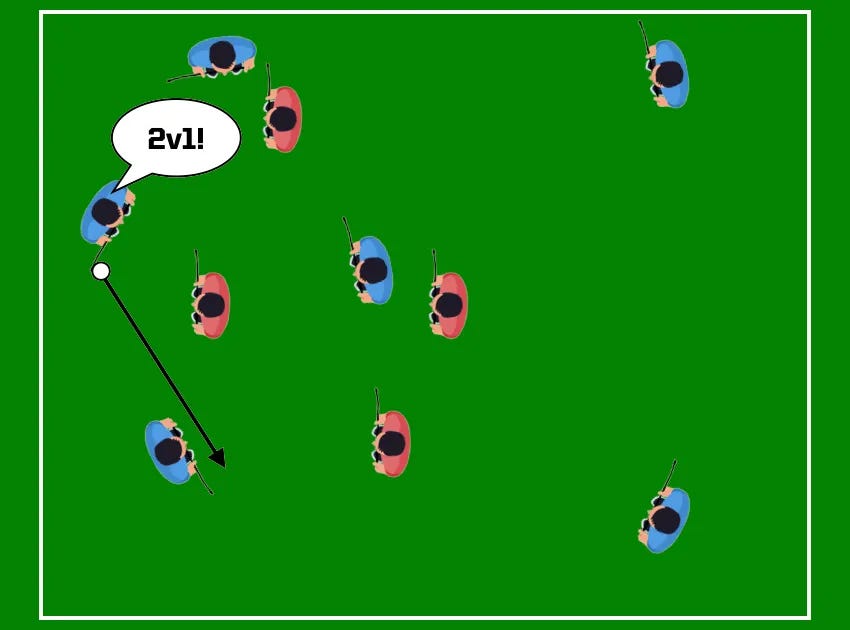The 2v1
While it may seem like a basic situation, the 2v1 is the key to the entire game.
Although I had chosen another topic for today, I felt that I couldn't go deeper without first making the fundamental concepts of the 2v1 very clear. So, this will be the first episode in a series where I want to talk about numerical superiority and the different ways to play it.
The 2v1 might seem like a simple and obvious situation. But for that very reason, it is often taken for granted. And therein lies the problem. I believe there are many key details to playing it well that aren't always coached with the attention they deserve.
Personally, I am a huge fan of the 2v1. I'm convinced that a team that knows how to identify and execute 2v1s efficiently is a team that plays hockey well. In the video below, we can see how Australia manages to reach the opponent's goal using 2v1s all over the field:
👉 Let's go to the basics: What makes up a 2v1?
To find a 2v1 on the field, we need three defined roles:
A player with the ball (Passer)
A teammate who is a passing option (Receiver)
An opponent who is defending (Defender).
Throughout this text, I will use these names to make the analysis easier to follow.
I need to make a clarification:
I'm not entirely happy with those terms. "Passer" and "Receiver" imply that a pass must necessarily occur... and you don't always need to pass the ball to solve the 2v1. But between saying "Passer" or "Ball Carrier," I'll stick with the shorter version.
📝 Key Concepts
It's crucial to understand the concept of the "Winning Pass":
The winning pass is the pass that breaks the line and eliminates the defender.
For that to happen, the receiver must be well-positioned:
As high up the field as possible, always outside the defender's range of action.
❌ Most Common Receiver Errors
Receiver too high: The pass has to travel through the defender's range of action, who can intercept it (Risky Pass). In tight spaces, sometimes there is no other option, but if we can choose, it's best to avoid it.
Receiver too low: The pass doesn't break any lines. It generates no advantage. It's almost a neutral pass because the same defender can continue to pressure the ball. Plus, we add a margin for error that contributes nothing
Closed stance: Receiving without a good body shape makes the next action slow, allowing the defender to close down. The stance should be open, so that the reception itself breaks the defensive line and continues forward.
✅ Tips for the Passer
There is always a lot of talk about the Receiver and their positioning. But the behavior of the player carrying the ball is rarely given enough importance. And in reality, they are the most important part of the 2v1.
🚕 Don't pass the ball from too far away
If we pass from too far, the defender has more time: they can intercept the pass or pressure the Receiver.
The key is to dribble and advance until you commit the defender.
Only when the defender is forced to make a choice can we make a winning pass.
🏑 Ball position while dribbling
It's essential to carry the ball in the right place.
It must be positioned in a way that allows us to pass it at the right moment, and in any direction.
The winning pass appears for a second... and then it's gone.
If I have to adjust the ball to make the pass, that second has already passed. And the play will most likely fail.
(If you're interested in this topic, you can read the episode: "Show me where you carry the ball, and I'll tell you how good you are")
😍 This video is a perfect 2v1:
The posture, the position of the ball during the dribble
The push pass off the right foot while on the run
The receiver's positioning (perfect height, outside the range of action)
The receiving body shape to break the line and prepare for the next play
🤔 Do I always need a pass?
As we mentioned earlier, NO.
The 2v1 is a situation where two players on our team try to put a defender in check, forcing them to make a decision.
Usually, at some point, the defender commits to pressuring the player with the ball, so the most common solution is the winning pass.
In other cases, perhaps the defender prioritizes marking the receiver. The solution, then, could be to continue dribbling without passing, if that guarantees I break the defensive line.
In the video, we can see an example of how a player wins the 2v1 without passing the ball. It's not a minor detail how he uses a feint to make the defender commit to defending the pass, and then, with a roll, he breaks the line.
Good dribbling posture + Pass fake + Roll = Elimination without needing a pass
📋 Mini-drills to train it
Just setting up a space with one defender and two attackers with a ball is enough. I would always try to add a subsequent action so that once they break the line, they have to progress (a shot on goal, a pass to another player, another space with a second defender to play another 2v1, etc.).
The image shows an example of a simple exercise, with two squares where the attacking players will play a 2v1 in each.
Some important points:
I would always have them start a little behind the square to force them to enter dribbling. If they start inside the square, they sometimes open with a pass, which is not ideal, as getting used to dribbling and passing on the move is very important.
I would leave a channel between the two squares, so the defense is somewhat restricted and the attackers can set up between one 2v1 and the next.
I would set a maximum limit of 1 pass per square: This way, we ensure they don't make neutral passes and always look for either a winning pass or to dribble past the defender and continue.
You can play "with offside." The receiver cannot go past the line of the defender. The goal would be to prevent it from turning into a vertical 2v1 (receiver behind the defender), as that is a different game situation.
Some other ideas for exercises/games:
An even-sided game (3v3, 4v4, 5v5, or whatever) where the defense is restricted (each defender can only defend one zone), while the attacking team can play freely. This way, they can create overloads and 2v1s.
Possession games with numerical superiority where the team with the ball, to score a point, has to shout "2v1!" every time they identify one and execute it correctly.
As always, these are just some sparks to get you thinking and creating your own games!
📲 Please, if you liked it, share it
Until next time!
Javi





